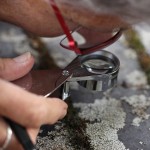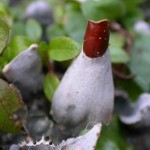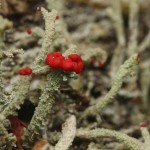Fay Newbery led a lichen walk at the Whiteknights Campus of the University of Reading on the afternoon of Sunday 21st September. Meeting point was the car park of the Harborne Building and first stop was an Acer in the corner of the car park. Fay described the difference between crustose and foliose lichens and the group were invited to inspect with hand lenses the lichens on the Acer. The most common crustose lichens were Lecidella elaeochroma, with black apothecia, and Lecanora chlarotera, whose apothecia are brown with a white margin, looking like jam tarts. The commonest foliose lichens were Parmelia sulcata, with tiny ridges, and Punctelia subrudecta, with soredia in distinct spots. The group were then challenged to find as many different species of lichen as possible on the paving stones which surround the car park.
Next stop was a line of three Prunus trees next to the road outside the car park. It was noted that the lichens were densest in the forks of the trees, where moisture could accumulate. The adjacent Prunus hedge also had some pink patches, which were caused by a fungus which grows on lichens. The group next went to inspect the ageing paintwork round the windows on the nearest building. The commonest lichen here was Physcia adscendens, which had tiny hair-like cilia on the ends of the helmet-shaped lobes. Also seen here was the yellow foliose lichen Xanthoria parietina, which flourishes in nitrogen-rich locations. A Sorbus tree had the distinctly apple-green foliose lichen Flavoparmelia caperata. A short distance further on was a wall, with different lichens on the bricks and on the mortar. A nearby Poplar tree showed a distinct rain shadow – there were no lichens immediately below a branch. The Horse Chestnut on the other side of the road was pointed out as unlikely to have much to see in the way of lichens – its weeping shape meant that rain was carried downwards through the outer branches, rather than running down the trunk.
The group then walked back to a flower bed behind the glass houses. On the bare soil were specimens of the tiny black foliose lichen Collema tenax. Further on were distinctive Peltigera lichens, with brown fruiting tips on the top surface of vertical grey thalli. The gravel bed next to the glass houses had a dense covering of a thalloid liverwort, Marchantia polymorpha. The botanists spotted the tiny flowers of Small Toadflax here. After inspecting the gate for lichens (it had recently been cleaned, removing most of its lichen coating), the group headed out to The Wilderness. A fallen tree trunk had a number of Cladonia species. Some had red-tipped podetia, some had cup-shaped fruits, one had brown fruits. A Cherry tree had a coating of the granular orange alga Trentapohlia, which is apparently, despite its colour, a kind of green alga. An Oak had several fructicose lichens, including Ramulina fastigata, with trumpet-like fruits, and the commoner Ramulina farinacea. It also had Evernia prunasti, which looks fructicose but is actually foliose, with a grey-green upper surface and a white lower surface. Finally, a Sycamore had a pale crustose fungus with irregular black fruits, Arthonia radiata.
Pictures by Sue White and Jan Haseler






